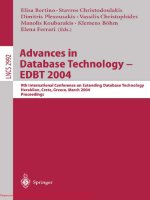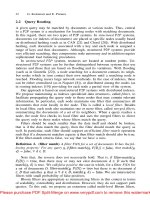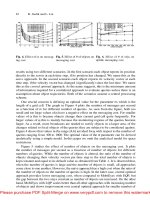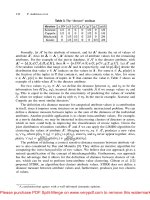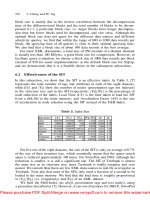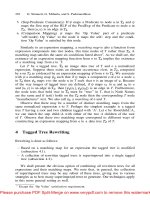Tài liệu Innovation In Information Technology doc
Bạn đang xem bản rút gọn của tài liệu. Xem và tải ngay bản đầy đủ của tài liệu tại đây (665.13 KB, 17 trang )
Innovation in Information Technology (Free Executive Summary)
/>Free Executive Summary
ISBN: 978-0-309-08980-7, 84 pages, 6x9, paperback (2003)
This executive summary plus thousands more available at www.nap.edu.
Innovation in Information Technology
National Research Council
This free executive summary is provided by the National Academies as
part of our mission to educate the world on issues of science, engineering,
and health. If you are interested in reading the full book, please visit us
online at . You may browse and
search the full, authoritative version for free; you may also purchase a print
or electronic version of the book. If you have questions or just want more
information about the books published by the National Academies Press,
please contact our customer service department toll-free at 888-624-8373.
Copyright © National Academy of Sciences. All rights reserved. Unless otherwise
indicated, all materials in this PDF file are copyrighted by the National Academy of
Sciences. Distribution or copying is strictly prohibited without permission of the National
Academies Press Permission is granted for this material
to be posted on a secure password-protected Web site. The content may not be posted
on a public Web site.
Copyright © National Academy of Sciences. All rights reserved.
This executive summary plus thousands more available at
Innovation in Information Technology
/>1
Summary and Recommendations
Progress in information technology (IT) has been remarkable, but the
best truly is yet to come: the power of IT as a human enabler is just begin-
ning to be realized. Whether the nation builds on this momentum or
plateaus prematurely depends on today’s decisions about fundamental
research in computer science (CS) and the related fields behind IT.
The Computer Science and Telecommunications Board (CSTB) has
often been asked to examine how innovation occurs in IT, what the most
promising research directions are, and what impacts such innovation
might have on society. Consistent themes emerge from CSTB studies,
notwithstanding changes in information technology itself, in the IT-pro-
ducing sector, and in the U.S. university system, a key player in IT re-
search.
In this synthesis report, based largely on the eight CSTB reports enu-
merated below, CSTB highlights these themes and updates some of the
data that support them. Much of the material is drawn from (1) the 1999
CSTB report Funding a Revolution: Government Support for Computing Re-
search,
1
written by both professional historians and computer scientists to
ensure its objectivity, and (2) Making IT Better: Expanding Information Tech-
1
Computer Science and Telecommunications Board, National Research Council. 1999.
Funding a Revolution: Government Support for Computing Research. National Academy Press,
Washington, D.C.
Copyright © National Academy of Sciences. All rights reserved.
This executive summary plus thousands more available at
Innovation in Information Technology
/>2 INNOVATION IN INFORMATION TECHNOLOGY
nology Research to Meet Society’s Needs,
2
the 2000 CSTB report that focuses
on long-term goals for maintaining the vitality of IT research. Many of
the themes achieved prominence in (3) the 1995 CSTB report Evolving the
High Performance Computing and Communications Initiative to Support the
Nation’s Information Infrastructure,
3
known informally as the Brooks-
Sutherland report. Other reports contributing to this synthesis include
(4) Computing the Future: A Broader Agenda for Computer Science and Engi-
neering (1992),
4
(5) Building a Workforce for the Information Economy (2001),
5
(6) Academic Careers in Experimental Computer Science and Engineering
(1994),
6
(7) Embedded, Everywhere: A Research Agenda for Networked Systems
of Embedded Computers (2001),
7
and (8) More Than Screen Deep: Toward
Every-Citizen Interfaces to the Nation’s Information Infrastructure (1997).
8
In
the text that follows, these reports are cited by number as listed, for easy
reference, in Box 1.
Here are the most important themes from CSTB’s studies of innova-
tion in IT:
• The results of research
■
America’s international leadership in IT—leadership that is vital
to the nation—springs from a deep tradition of research (1,3,4).
■
The unanticipated results of research are often as important as
the anticipated results—for example, electronic mail and instant messag-
ing were by-products of research in the 1960s that was aimed at making it
2
Computer Science and Telecommunications Board, National Research Council. 2000.
Making IT Better: Expanding Information Technology Research to Meet Society’s Needs. National
Academy Press, Washington, D.C.
3
Computer Science and Telecommunications Board, National Research Council. 1995.
Evolving the High Performance Computing and Communications Initiative to Support the Nation’s
Information Infrastructure. National Academy Press, Washington, D.C.
4
Computer Science and Telecommunications Board, National Research Council. 1992.
Computing the Future: A Broader Agenda for Computer Science and Engineering. National Acad-
emy Press, Washington, D.C.
5
Computer Science and Telecommunications Board, National Research Council. 2001.
Building a Workforce for the Information Economy. National Academy Press, Washington,
D.C.
6
Computer Science and Telecommunications Board., National Research Council. 1994.
Academic Careers in Experimental Computer Science and Engineering. National Academy Press,
Washington, D.C.
7
Computer Science and Telecommunications Board, National Research Council. 2001.
Embedded, Everywhere: A Research Agenda for Networked Systems of Embedded Computers. Na-
tional Academy Press, Washington, D.C.
8
Computer Science and Telecommunications Board, National Research Council. 1997.
More Than Screen Deep: Toward Every-Citizen Interfaces to the Nation’s Information Infrastruc-
ture. National Academy Press, Washington, D.C.
Copyright © National Academy of Sciences. All rights reserved.
This executive summary plus thousands more available at
Innovation in Information Technology
/>SUMMARY AND RECOMMENDATIONS 3
BOX 1
Reference Numbers for Key CSTB Titles Cited in This Report
Reference Title
Number
(1)
Funding a Revolution: Government Support for Computing
Research
(1999)
(2)
Making IT Better: Expanding Information Technology Research to
Meet Society’s Needs
(2000)
(3)
Evolving the High Performance Computing and Communications
Initiative to Support the Nation’s Information Infrastructure
(1995)
(4)
Computing the Future: A Broader Agenda for Computer Science
and Engineering
(1992)
(5)
Building a Workforce for the Information Economy
(2001)
(6)
Academic Careers in Experimental Computer Science and
Engineering
(1994)
(7)
Embedded, Everywhere: A Research Agenda for Networked
Systems of Embedded Computers
(2001)
(8)
More Than Screen Deep: Toward Every-Citizen Interfaces to the
Nation’s Information Infrastructure
(1997)
NOTE: Complete citations for these reports appear in footnotes 1 through 8 in this “Summary
and Recommendations” section.
possible to share expensive computing resources among multiple simul-
taneous interactive users (1,3).
■
The interaction of research ideas multiplies their impact—for
example, concurrent research programs targeted at integrated circuit
design, computer graphics, networking, and workstation-based comput-
ing strongly reinforced and amplified one another (1-4).
• Research as a partnership
■
The success of the IT research enterprise reflects a complex part-
nership among government, industry, and universities (1-8).
■
The federal government has had and will continue to have an
essential role in sponsoring fundamental research in IT—largely univer-
sity-based—because it does what industry does not and cannot do (1-8).
Industrial and governmental investments in research reflect different
Copyright © National Academy of Sciences. All rights reserved.
This executive summary plus thousands more available at
Innovation in Information Technology
/>4 INNOVATION IN INFORMATION TECHNOLOGY
motivations, resulting in differences in style, focus, and time horizon
(1-3,7,8).
■
Companies have little incentive to invest significantly in activi-
ties whose benefits will spread quickly to their rivals (1,3,7). Fundamen-
tal research often falls into this category. By contrast, the vast majority of
corporate research and development (R&D) addresses product and
process development (1,2,4).
■
Government funding for research has leveraged the effective
decision making of visionary program managers and program office
directors from the research community, empowering them to take risks in
designing programs and selecting grantees (1,3). Government sponsor-
ship of research especially in universities also helps to develop the IT
talent used by industry, universities, and other parts of the economy (1-5).
• The economic payoff of research
■
Past returns on federal investments in IT research have been
extraordinary for both U.S. society and the U.S. economy (1,3). The trans-
formative effects of IT grow as innovations build on one another and as
user know-how compounds. Priming that pump for tomorrow is today’s
challenge.
■
When companies create products using the ideas and workforce
that result from federally sponsored research, they repay the nation in
jobs, tax revenues, productivity increases, and world leadership (1,3,5).
The themes highlighted above underlie two recurring and overarching
recommendations evident in the eight CSTB reports cited:
Recommendation 1 The federal government should continue to
boost funding levels for fundamental information technology research,
commensurate with the growing scope of research challenges (2-4,6-8). It
should ensure that the major funding agencies, especially the National
Science Foundation and the Defense Advanced Research Projects Agency,
have strong and sustained programs for computing and communications
research that are broad in scope and independent of any special initiatives
that might divert resources from broadly based basic research (2,3).
Recommendation 2 The government should continue to maintain
the special qualities of federal IT research support, ensuring that it comple-
ments industrial research and development in emphasis, duration, and
scale (1-4,6).
This report addresses the ways that past successes can guide federal
funding policy to sustain the IT revolution and its contributions to other
fields.
Copyright © National Academy of Sciences. All rights reserved.
This executive summary plus thousands more available at
Innovation in Information Technology
/>Innovation
in INFORMATION
TECHNOLOGY
Computer Science and Telecommunications Board
Division on Engineering and Physical Sciences
THE NATIONAL ACADEMIES PRESS
Washington, D.C.
www.nap.edu
Copyright © National Academy of Sciences. All rights reserved.
This executive summary plus thousands more available at
Innovation in Information Technology
/>THE NATIONAL ACADEMIES PRESS 500 Fifth Street, N.W. Washington, DC 20001
NOTICE: The projects that are the basis of this synthesis report were approved by
the Governing Board of the National Research Council, whose members are drawn
from the councils of the National Academy of Sciences, the National Academy of
Engineering, and the Institute of Medicine. The members of the committees re-
sponsible for the final reports of these projects and of the board that produced this
synthesis were chosen for their special competences and with regard for appropri-
ate balance.
Support for this project was provided by the core sponsors of the Computer
Science and Telecommunications Board (CSTB), which include the Air Force Of-
fice of Scientific Research, Cisco Systems, Defense Advanced Research Projects
Agency, Department of Energy, Intel Corporation, Microsoft Research, National
Aeronautics and Space Administration, National Institute of Standards and Tech-
nology, National Library of Medicine, National Science Foundation, and Office of
Naval Research. Sponsors enable but do not influence CSTB’s work. Any opin-
ions, findings, conclusions, or recommendations expressed in this publication are
those of the authors and do not necessarily reflect the views of the organizations
or agencies that provide support for CSTB.
International Standard Book Number 0-309-08980-8 (book)
International Standard Book Number 0-309-52622-1 (PDF)
Copies of this report are available from the National Academies Press, 500 Fifth
Street, N.W., Lockbox 285, Washington, DC 20055, (800) 624-6242 or (202) 334-
3313 in the Washington metropolitan area; Internet: .
Copyright 2003 by the National Academy of Sciences. All rights reserved.
Printed in the United States of America
Copyright © National Academy of Sciences. All rights reserved.
This executive summary plus thousands more available at
Innovation in Information Technology
/>The National Academy of Sciences is a private, nonprofit, self-perpetuating soci-
ety of distinguished scholars engaged in scientific and engineering research, dedi-
cated to the furtherance of science and technology and to their use for the general
welfare. Upon the authority of the charter granted to it by the Congress in 1863,
the Academy has a mandate that requires it to advise the federal government on
scientific and technical matters. Dr. Bruce M. Alberts is president of the National
Academy of Sciences.
The National Academy of Engineering was established in 1964, under the charter
of the National Academy of Sciences, as a parallel organization of outstanding
engineers. It is autonomous in its administration and in the selection of its mem-
bers, sharing with the National Academy of Sciences the responsibility for advis-
ing the federal government. The National Academy of Engineering also sponsors
engineering programs aimed at meeting national needs, encourages education
and research, and recognizes the superior achievements of engineers. Dr. Wm. A.
Wulf is president of the National Academy of Engineering.
The Institute of Medicine was established in 1970 by the National Academy of
Sciences to secure the services of eminent members of appropriate professions in
the examination of policy matters pertaining to the health of the public. The
Institute acts under the responsibility given to the National Academy of Sciences
by its congressional charter to be an adviser to the federal government and, upon
its own initiative, to identify issues of medical care, research, and education.
Dr. Harvey V. Fineberg is president of the Institute of Medicine.
The National Research Council was organized by the National Academy of
Sciences in 1916 to associate the broad community of science and technology with
the Academy’s purposes of furthering knowledge and advising the federal gov-
ernment. Functioning in accordance with general policies determined by the
Academy, the Council has become the principal operating agency of both the
National Academy of Sciences and the National Academy of Engineering in pro-
viding services to the government, the public, and the scientific and engineering
communities. The Council is administered jointly by both Academies and the
Institute of Medicine. Dr. Bruce M. Alberts and Dr. Wm. A. Wulf are chair and
vice chair, respectively, of the National Research Council.
www.national-academies.org
Copyright © National Academy of Sciences. All rights reserved.
This executive summary plus thousands more available at
Innovation in Information Technology
/>iv
COMPUTER SCIENCE AND TELECOMMUNICATIONS BOARD
DAVID D. CLARK, Massachusetts Institute of Technology, Chair
ERIC BENHAMOU, 3Com Corporation
DAVID BORTH, Motorola Labs
JAMES CHIDDIX,** AOL Time Warner
JOHN M. CIOFFI, Stanford University
ELAINE COHEN, University of Utah
W. BRUCE CROFT, University of Massachusetts at Amherst
THOMAS E. DARCIE, University of Victoria
JOSEPH FARRELL, University of California at Berkeley
JOAN FEIGENBAUM, Yale University
HECTOR GARCIA-MOLINA, Stanford University
SUSAN L. GRAHAM,* University of California at Berkeley
JUDITH HEMPEL,* University of California at San Francisco
JEFFREY M. JAFFE,** Bell Laboratories, Lucent Technologies
ANNA KARLIN,** University of Washington
WENDY KELLOGG, IBM Thomas J. Watson Research Center
BUTLER W. LAMPSON, Microsoft Corporation
EDWARD D. LAZOWSKA,** University of Washington
DAVID LIDDLE, U.S. Venture Partners
TOM M. MITCHELL, Carnegie Mellon University
DONALD NORMAN,** Nielsen Norman Group
DAVID A. PATTERSON, University of California at Berkeley
HENRY (HANK) PERRITT, Chicago-Kent College of Law
DANIEL PIKE, GCI Cable and Entertainment
ERIC SCHMIDT, Google Inc.
FRED SCHNEIDER, Cornell University
BURTON SMITH, Cray Inc.
TERRY SMITH,** University of California at Santa Barbara
LEE SPROULL, New York University
WILLIAM STEAD, Vanderbilt University
JEANNETTE M. WING, Carnegie Mellon University
MARJORY S. BLUMENTHAL, Director
KRISTEN BATCH, Research Associate
JENNIFER BISHOP, Senior Project Assistant
JANET BRISCOE, Administrative Officer
DAVID DRAKE, Senior Project Assistant
**Term ended June 30, 2001.
**Term ended June 30, 2002.
Copyright © National Academy of Sciences. All rights reserved.
This executive summary plus thousands more available at
Innovation in Information Technology
/>v
JON EISENBERG, Senior Program Officer
RENEE HAWKINS, Financial Associate
PHIL HILLIARD, Research Associate
MARGARET MARSH HUYNH, Senior Project Assistant
ALAN S. INOUYE, Senior Program Officer
HERBERT S. LIN, Senior Scientist
LYNETTE I. MILLETT, Program Officer
DAVID PADGHAM, Research Associate
CYNTHIA A. PATTERSON, Program Officer
JANICE SABUDA, Senior Project Assistant
BRANDYE WILLIAMS, Staff Assistant
STEVEN WOO, Dissemination Officer
NOTE: For more information on CSTB, see its Web site at <>, write to
CSTB, National Research Council, 500 Fifth Street, N.W., Washington, DC 20001, call at
(202) 334-2605, or e-mail the CSTB at
Copyright © National Academy of Sciences. All rights reserved.
This executive summary plus thousands more available at
Innovation in Information Technology
/>Copyright © National Academy of Sciences. All rights reserved.
This executive summary plus thousands more available at
Innovation in Information Technology
/>vii
Preface
The health of the computer science field and related disciplines has
been an enduring concern of the National Research Council’s Computer
Science and Telecommunications Board (CSTB). From its first reports in
the late 1980s, CSTB has examined the nature, conduct, scope, and direc-
tions of the research that drives innovation in information technology.
Ironically, the success of the industries that produce information tech-
nology (IT) has caused confusion about the roles of government and
academia in IT research. And it does not help that research in computer
science—especially research relating to software—is hard for many people
outside the field to understand. This synthesis report draws on several
CSTB reports, published over the course of the past decade, to explain the
what and why of IT research. It was developed by members of the board,
drawing on CSTB’s body of work and on insights and experience from
their own careers.
This synthesis is kept brief in order to highlight key points. It is
paired with a set of excerpts from previous reports, chosen either for their
explanation of relevant history or for their compelling development of
core arguments and principles.
David D. Clark, Chair
Computer Science and
Telecommunications Board
Copyright © National Academy of Sciences. All rights reserved.
This executive summary plus thousands more available at
Innovation in Information Technology
/>Copyright © National Academy of Sciences. All rights reserved.
This executive summary plus thousands more available at
Innovation in Information Technology
/>ix
Acknowledgment of Reviewers
This report has been reviewed in draft form by individuals chosen for
their diverse perspectives and technical expertise, in accordance with pro-
cedures approved by the National Research Council’s Report Review
Committee. The purpose of this independent review is to provide candid
and critical comments that will assist the institution in making its pub-
lished report as sound as possible and to ensure that the report meets
institutional standards for objectivity, evidence, and responsiveness to
the study charge. The review comments and draft manuscript remain
confidential to protect the integrity of the deliberative process. We wish
to thank the following individuals for their review of this report:
Frederick P. Brooks, Jr., University of North Carolina at Chapel Hill,
Linda Cohen, University of California at Irvine,
Samuel H. Fuller, Analog Devices Inc.,
Juris Hartmanis, Cornell University,
Timothy Lenoir, Stanford University,
David G. Messerschmitt, University of California at Berkeley,
Ivan E. Sutherland, Sun Microsystems Laboratories, and
Joseph F. Traub, Columbia University.
Although the reviewers listed above have provided many construc-
tive comments and suggestions, they were not asked to endorse the con-
clusions or recommendations, nor did they see the final draft of the report
before its release. The review of this report was overseen by John
Copyright © National Academy of Sciences. All rights reserved.
This executive summary plus thousands more available at
Innovation in Information Technology
/>x ACKNOWLEDGMENT OF REVIEWERS
Hopcroft, Cornell University. Appointed by the National Research Coun-
cil, he was responsible for making certain that an independent examina-
tion of this report was carried out in accordance with institutional proce-
dures and that all review comments were carefully considered.
Responsibility for the final content of this report rests entirely with the
authoring board and the institution.
Copyright © National Academy of Sciences. All rights reserved.
This executive summary plus thousands more available at
Innovation in Information Technology
/>xi
Contents
SUMMARY AND RECOMMENDATIONS 1
1 INNOVATION IN INFORMATION TECHNOLOGY 5
Universities, Industry, and Government: A Complex
Partnership Yielding Innovation and Leadership, 5
The Essential Role of the Federal Government, 9
The Distinctive Character of Federally Supported Research, 15
University Research and Industrial R&D, 20
Hallmarks of Federally Sponsored IT Research, 22
Looking Forward, 26
2 EXCERPTS FROM EARLIER CSTB REPORTS 30
Making IT Better: Expanding Information Technology
Research to Meet Society’s Needs (2000), 31
The Many Faces of Information Technology Research, 31
Implications for the Research Enterprise, 33
Funding a Revolution: Government Support for Computing
Research (1999), 37
Lessons from History, 37
Sources of U.S. Success, 44
Research and Technological Innovation, 46
The Benefits of Public Support of Research, 47
Maintaining University Research Capabilities, 48
Copyright © National Academy of Sciences. All rights reserved.
This executive summary plus thousands more available at
Innovation in Information Technology
/>xii CONTENTS
Creating Human Resources, 49
The Organization of Federal Support: A Historical Review, 50
1945-1960: Era of Government Computers, 51
The Government’s Early Role, 52
Establishment of Organizations, 53
Observations, 57
1960-1970: Supporting Continuing Revolution, 58
Maturing of a Commercial Industry, 58
The Changing Federal Role, 60
1970-1990: Retrenching and International Competition, 67
Accomplishing Federal Missions, 67
Evolving the High Performance Computing and Communications
Initiative to Support the Nation’s Information Infrastructure
(1995), 68
Continued Federal Investment Is Necessary to Sustain
Our Lead, 68
WHAT IS CSTB? 71


